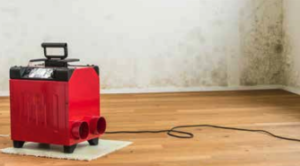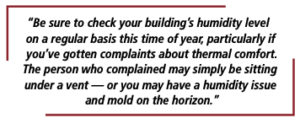The Big, Furry Problem with Humidity
AND HOW TO AVOID IT IN YOUR BUILDINGS
 I’m sitting in my backyard right now to write this newsletter. It has rained for the past two days, so Houston is currently 77 degrees F with 68% humidity. I feel very comfortable out here watching the wind in the trees and listening to the birds chirp and chitter. But I know if the humidity edged higher, I’d head right back inside.
I’m sitting in my backyard right now to write this newsletter. It has rained for the past two days, so Houston is currently 77 degrees F with 68% humidity. I feel very comfortable out here watching the wind in the trees and listening to the birds chirp and chitter. But I know if the humidity edged higher, I’d head right back inside.
I never let my home reach 68% humidity and neither should you. In houses and commercial buildings, the ideal humidity level is below 60%, and frankly, I recommend 55% or lower to my clients. If you let the water content in the air get higher than that, you’ll be courting two big problems: reduced thermal comfort and mold.
First, let’s talk about thermal comfort. This is a technical term we use in the industry to describe that sweet spot where office workers aren’t too hot or too cold. It’s a combination of air temperature and humidity. You see, your skin is like the radiator on a car. It regulates your temperature and helps your body cool itself. You sweat, the sweat evaporates, and you feel more comfortable.
 This process works well in low humidity, like you find in desert areas like El Paso (which was 98 degrees F with 4% humidity last time I visited), Phoenix, and the plains of Colorado. But the more moisture there is in the air, the less effectively your body can cool itself. There’s nowhere for your sweat to evaporate to! That’s why tenants report feeling unbearably warm if indoor humidity reaches 65%–75% … even when the temperature is only 68 degrees F.
This process works well in low humidity, like you find in desert areas like El Paso (which was 98 degrees F with 4% humidity last time I visited), Phoenix, and the plains of Colorado. But the more moisture there is in the air, the less effectively your body can cool itself. There’s nowhere for your sweat to evaporate to! That’s why tenants report feeling unbearably warm if indoor humidity reaches 65%–75% … even when the temperature is only 68 degrees F.
That said, thermal comfort isn’t the only reason to keep humidity at 60% or lower in commercial buildings. There’s an even bigger worry: mold. High humidity encourages mold growth, and I’ve found it on window shades, curtains, and fabric in buildings with excess humidity. Once, I investigated a mold issue in the waiting room of a judge’s office and discovered that although the custodians cleaned the cushions of the couch, the outside edges and back were furred with mold! They had no idea humidity was the cause of the problem.
Managing humidity is crucial for maintaining healthy buildings and healthy tenants. Fortunately, most building engineers and managers I work with keep a close eye on the humidity in their buildings. You do a fantastic job of keeping your tenants comfortable and your spaces mold-free. But it never hurts to double-check these things, especially in the summer!
Be sure to check your building’s humidity level on a regular basis this time of year, particularly if you’ve gotten complaints about thermal comfort. The person who complained may simply be sitting under a vent — or you may have a humidity issue and mold on the horizon.
To read a horror story about a mold problem I encountered recently in an 18-story building, turn to Page 2. You won’t believe how much havoc the humidity wreaked!
Wishing you a mold-free summer,

